Jews in Africa Part III - Egypt, Elephantine Island, and the Jews
Fact Paper 19-III
© Samuel Kurinsky, all rights reserved
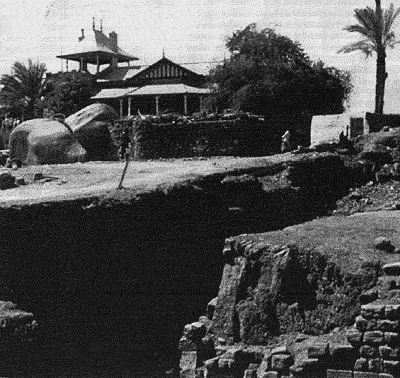
- Early Semitic Presence in Egypt
- The Island of Yeb
- The Judaic Community on Yeb
- Life of the Judaic Yeb Community
- Historical Crimes of Omission and Commission
- Notes
Early Semitic Presence in Egypt
The dean of Egyptian archaeologists, the revered James Henry Breasted, to whom Egyptology is everlastingly indebted for having spent the better part of a lifetime digging in the ruins and preserving inscriptions, took note early on of the profound impact the Semitic peoples had on the evolution of Egyptian civilization. In 1905 Breasted wrote: " It was chiefly at the two northern corners of the Delta that outside influences and foreign elements, who were always sifting into the Nile valley, gained access to the country... The Semitic immigration from Asia, examples of which are also observable in the [Egyptian] historic age, occurred in an epoch that lies below our earliest historical horizon."1
Sir Flinders Petrie, whose status in Egyptology is on a par with that of Breasted, was similarly impressed with the extent of Semitic influence and was convinced of the fundamental Asian origin of Egyptian civilization. The region of the Nile delta (Biblical Goshen) was contiguous to Asia. Until the conquest of the area of the Lower Nile by an Egyptian chieftain of the Upper Nile and the establishment of the First Egyptian Dynasty, it was populated by peoples whose culture and technologies derived from the Canaanite and Mesopotamian milieu.
Since the time of the intrepid researchers such as Breasted and Petrie, certain influential archaeologists dismissed their observations as being unduly influenced by Biblical lore. But after a period of skepticism and rejection, new discoveries have consistently justified Petrie's and Breasted's observations.
"Many scholars today accept that at some time during the Pre-dynastic period a new group of people arrived in Egypt and their advent resulted in profound changes in many aspects of the civilization," stated A. Rosalie David.2
Percy Handcock concurred, and added etymological evidence: "The Semites swept over Egypt and the north coast of Africa, impressing their indelible and unmistakable stamp upon the foundation-structure of the Egyptian and Libyan languages."3.
Other scholars likewise took issue with the nay-sayers: Sir Alan Gardiner: "... the relationship with Semitic [languages] is unmistakable;"4 Will Durant: "The further back we trace the Egyptian language the more affinities it reveals with the Semitic languages of the Near East., the pictographic writings of the pre-dynastic Egyptians seems to have come in from Sumeria;5"; W. Wendorf summed up by stating that the early Pre-dynastic culture record the arrival of a new population in Egypt who brought with them the cultural base from which Egyptian civilization was to develop."6
Pre-dynastic Egyptians were confined to Upper Egypt, virtually isolated. They had no resources conducive to the development of more than a neolithic culture. The area was known as the "Red Land," distinguishing the predominately barren desert lands from the "Black Land," the fertile alluvium of the Delta region to the north.
The Delta was lush with foliage, a swampy quagmire, which, however, dried up sufficiently during a portion of the year to support herds of foraging animals. From time immemorial the area had been a vital, fecund reserve for the peoples of Southwest Asia. These Asians brought cattle and sheep and goats across the sands of the Sinai to graze in the Delta during the recurrent periods in which drought desiccated Canaan.
The wide sweep of the Delta was not merely a seasonally pastoral Eden; hillocks arising from the alluvial areas provided islands of permanently dry land where agricultural settlements were established by the Asiatics. These gezirat (Arabic for "turtlebacks") are sedimentary relics which proliferated in the Pleistone Age. Such settlements already existed thousands of years before Abraham is said to have arrived with his entourage and his herds of animals to await a better season for the completion of his aliya to Canaan.
Merimde beni-Salame was one such a community, situated 37 miles northwest of present-day Cairo.7 It is one of the earliest known farming villages in Lower Egypt, having been settled about 4880 BCE and remaining occupied thereafter for some 650 years.
The Merimdeans were radically different from the Pre-dynastic people of Upper Egypt in every respect - physically, culturally and technologically. Merimbe, wrote Michael Hoffman, "shows none of the distinctively Egyptian characteristics... Merimbe seems more like a village of sturdy yeoman farmers than a collection of peasants subject to the whims, avarice, and authority of a powerful man or government, although some cooperative efforts (if not centralization of food-producing tasks) are recalled by the threshing floors up to 13 feet in diameter."8 The Fayoum Basin, a natural oasis, likewise accommodated agricultural settlements going back to the fifth millennium BCE with many similarities to those on the hillocks of the Delta. Several sites north of the ancient Lake Moeris, now known as Lake Karoun, were explored by Gertrude Caton-Thompson and her geologist colleague Elinor Gardner in the winters of 1924-25 and 1925-26.
"Grains of emmer wheat and six-row barley filled many of the sunken silos that clustered on the high ground
that clustered on the high ground overlooking the small villages. Both of these plants are Middle Eastern domesticates."9
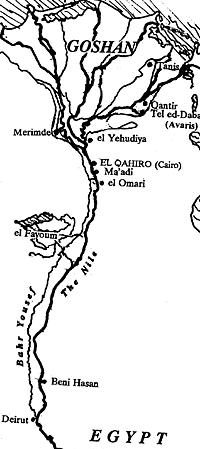
Between 5000 and 3500 BCE Asiatic settlements were established further up the Nile in enclaves along the river which were periodically flooded. Sun-dried bricks, a characteristic Mesopotamian building material, were first employed in Egypt during this period; the use of the distinctly Mesopotamian cylinder seal was introduced, and traces of writing appeared; they bore a marked resemblance to those of the Land of the Twin Rivers (Mesopotamia).
"The first attempts at a pictographic system of writing have also been traced... to the Jamdet Culture [of Mesopotamia]."10
During this period it is evident that Asiatic traders had already threaded their way past the indigenous Egyptians of Upper Egypt by boat and donkey to trade with the Nubians. The donkey was alien to Egypt. The Egyptians, in fact, had no pack animals during the entire Pre-dynastic period. The earliest remains of donkeys were found in various communities of Asiatic origins in the Delta. Donkeys were conspicuously present in Ma'adi, a village of Asiatics which was established south of present-day Cairo. Significant evidence of trade both with Asia and Nubia was found among the artifacts recovered from its ruins.
The Ma'adians were not only expert in agronomy and husbandry but were accomplished metallurgists and craftsmen. "A copper axe-head spoiled in casting and masses of copper ore indicate that copper was being processed at Ma'adi. Ma'adi is the oldest site in northern Egypt in which copper artifacts have been found."11
The people of Ma'adi were among the many communities of Asiatic peoples who had been active in northern Egypt for several millennia at the time it was invaded and destroyed. They suffered a cruel thanks for the technology, agronomic and industrial, that they had introduced into Egypt. "Ma'adi met a violent end as witnessed by widespread ash and human bones over the settlement. If so, then perhaps this was the 'final solution' arranged for the heterogenous society of Ma'adi by the victorious kings of the First Dynasty."12
Eleven Egyptian dynasties passed, and Egypt remained in the Chalcolithic, or Copper/Stone Age while the peoples of Southeast Asia advanced into the Late Bronze Age. Intermittently, during peaceful periods, Semitic traders found their way up the Nile to trade with the Nubians. The passage of such a caravan was recorded in full size by an Egyptian Baron, Knumhotpe, in his tomb at the end of the 19th century BCE. The 37 members of the group included a musician carrying a lyre, a musical instrument unknown in Egypt; one of the caravan's donkeys is depicted carrying a bellows, and another is depicted loaded with an anvil, bronze-working implements likewise unknown in Egypt at the time; one member is shown carrying a curvilineal, laminated bow and a quiver, again, items unknown in Egypt. The hieroglyphic inscription names the leader of the group "Abushei." Abushei is distinctly an Hebraic name; it was, for example, the name of King David's top general.
At the end of the twelfth dynasty, a propitious time of peace and accommodation with the Asiatics ensued The period coincides in time with the Biblical account of Joseph, and initiated what archaeologists term "The Second Intermediate Period" (roughly, 17th-15th centuries BCE). It was a period during which Egypt was ruled successively by six Semitic (Canaanite or Aramaic) kings.
These Semitic kings were referred to by the Egyptians as the Hyk Khase, or "rulers from a foreign hill country." The phrase "Hyk Khase" is commonly transformed into "Hyksos," a word which is not confined to the chieftains but is mistakenly applied to the Semitic people (termed the Aamu by the Egyptians) from which they stemmed.13 Although the hegemony of these "Asiatics" included all Egypt, Canaan and extended into a major portion of Mesopotamia, they established no dynasties. They were elected by the village chieftains (the Hyk Khase) of the Aamu villages, and therefore can be properly designated as the chief-of-chiefs.

The Hyk Khase worshiped a single God and made no statues of Him; they erected few gigantic monuments,14 self-glorifying statuary and self-serving temples such as those which so often drained Egypt of its resources of labor and material, for there were no godly kings among them. Many archaeologists, disappointed by the dearth of gargantuan toms and narcissistic statuary, dismally declare that during this period art declined. Museums petulantly concur, for lack of imposing mausoleums, mummies and exotic statuary of beastly idols to display. The lack of such artifacts cause museums to pass by the vibrant, prosperous and progressive two centuries of Egyptian history with scarcely a mention.
During the tenure of the Semitic chieftains Egypt leaped forward into a new era, advancing enormously in every field of knowledge and endeavor. Wise men came and taught astronomy, and medicine, and mathematics. The great mathematical Rhind papyrus, now in the British Museum, was produced during this period. Thus, although the chieftains sculpted no great statues of themselves, nor fashioned idols of fabulous gods, the arts they infused into Egyptian culture were of a subtler nature, more durable than the stone of which the statues were carved, and benefitted all Egyptians.
The Egyptians had been sailing the Nile in Feluccas, simple boats which were handled adeptly on the river. These boats, however, could not be managed easily on the high seas, for they had no keel. The Aamus had long incorporated a keel, which stabilized their ships and made them more maneuverable, safer and seaworthy. Consequently, trade with the islands of the Mediterranean blossomed, and Egypt became a more important factor in the region's economy.
Mesopotamian standards of weights were introduced.15 The Aramaic language and writing, which had replaced Akkadian as the lingua franca of the Semitic peoples, also became the language of international trade in Egypt as well.
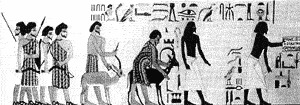
Wheels and wheeled vehicles, and the horses and oxen to draw them, were unknown in Egypt until the time of the rule of the Semitic chieftains. Wheeled chariots, hitched to teams of Asiatic horses, were introduced for hunting and for war, and the potters of Egypt began to throw their ware upon swiftly whirling wheels with newly won ease.
Both husbandry and agronomy were lifted toward Mesopotamian levels by the Canaanites who populated the Delta during the Second Intermediate Period. A great beast was introduced: The humpbacked Brahman or Zebu ox, an Indian beast that had been bred by the Semites to be adapted to the climate of the area. The domesticated chicken, also of Indian origin, had been well known in Akkadia for a thousand years. The cackling hen amazed the Egyptian farmers by their productivity as, almost daily, they plunked down another egg. So astonishing was the prolific performance of these barnyard fowl that Thutmose III inscribed on stone his perplexity about, and admiration for this "foreign bird which gives birth every day."
The Semites cultivated new fruits in Egypt - pomegranates, figs, olives, new grains and vegetables. Even the cornflower, a common Canaanite flower, became the favorite of Egyptian barons, and their tomb painters employed them lavishly.
Tools were refined and perfected. The Semites taught the people of Egypt how to set the helve, or handle, into a socket instead of tying the head crudely onto it. The simple bows the Egyptians used were no more than bent branch. They were replaced by the superior bows of the Aamus, cunningly constructed of bone and wood laminated into a composite curve. The shape and composition of scimitars, swords and daggers were modified to make them more effective and durable.
More important than weapons was the introduction of abiding inventions of peaceful use: new spinning devices and the upright loom; new fibers and new fast dyes made fabrics more durable and colorful; and added another dimension to the quality of life. The introduction of the gentler arts likewise contributed to a richer Egyptian culture. A variety of new musical instruments, the lute, the lyre, the oboe, the tambourine and the harp, long played in the Mesopotamian milieu, now appear in Egypt. With the new music came new forms of dance, and its graceful images became forever inscribed into the graffiti of the nobles, princes and pharaohs of Egypt fro that time forward. The Egyptians got to learn new Semitic games, and began to introduce them into their tombs to be able to amuse themselves into eternity. The astragal, a form of dice, made from the tarsal joint of a hoofed animal, were employed in such games as twenty squares, similar to the Indian parchesi, and in senet, a more ancient Mesopotamian game.
The Semites acquainted the Egyptian with new metals and propelled Egyptian society and culture into the Bronze Age.
It is most ironic, that the new bronze weapons, the chariots and the curvilinear bows, were responsible for the demise of Aamu rule. At first, a campaign by an Egyptian baron, Sequernene, to overthrow Hyk Khase rule was ignominiously defeated. One of his sons, Kamose, pled in vain to the other noblemen of Upper Egypt for their support. Kamose himself bitterly inscribed their refusal in stone, quoting how his neighboring Egyptian lords had expressed their content with the prosperity they enjoyed and had refused to join the insurrection. Kamose raised a mercenary army from a tribe of outlaw Nubians, and was likewise defeated. Kamose's brother Ahmose, however, took up the cause, and succeeded where his father and brother had failed.
Ahmose I became pharaoh and the Semitic rule of Egypt came to an end. The Aamu were expelled or enslaved, and progress came to a halt.
The Island of Yeb
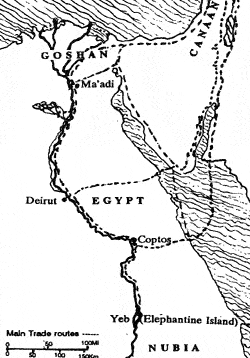
The Biblical island of Yeb, commonly known as Elephantine Island because of its shape like the head and trunk of an elephant, is located in the Nile near Aswan. It is close to Egypt's border with the Biblical land of Kush (Nubia, or contemporary Sudan). It had a serviceable harbor, and was very active following the time of Joseph.
Semitic peoples, called the Aamu or "Asiatics" by the Egyptians, established a colony during the "Second Intermediate Period" on Yeb and on the Eastern Nile bank at Syene (now Aswan) to trade with the Nubians. Artifacts excavated on the island by members of the German and Swiss Archaeological Institutes include uniquely Canaanite earthenware, which, together with other characteristic materials, clearly establish the ethnicity of the settlers. The pottery from Yeb proved to be a virtual replica of those recovered from the ancient Canaanite city of Ugarit and elsewhere in Canaan.
Glass beads, rings, and perfume vials, were also recovered from the site, and are now on display in the Elephantine Island Museum on Yeb. The Egyptians of the time were incapable of producing glass; their pyrotechnology was then limited to melting gold or copper on an open fire. In Akkadian Mesopotamia, however, reverberatory furnaces had already been in use for seven centuries and the technology and art of glassmaking had been known since 2400 BCE. In the 15th century BCE the art had already passed from Mesopotamia into Canaan. The presence of glassware of this period on Yeb is definitive; it testifies to the presence of Semitic traders on the island at the time.
During the period of Aamu rule, trade with Nubian Kush attained an unprecedented importance. Under the stimulation of peaceful trade, Kush emerged as a prominent and flourishing kingdom with close ties to Asia to the north. The Kush town of Kerma, for example, consisting largely of brick houses spread out along the river, was the seat of a court near the third Nile cataract. The houses and accouterments testify to a considerable affluence and taste for luxury goods. The tombs were filled with fine furnishings of all kinds, which must have included many items of gold before tomb robbers broke into them. A woman was interred wearing a silver crown, which somehow survived the intrusions. The dead were laid to rest on beds, one of which was found to be made of glazed quartz.
A great assortment of seal impressions on pots, baskets and various other receptacles were extracted from the debris. The seals eloquently attest to the close and amicable relationship which existed between the Nubians and the Asiatics. The only names which appear on these seal impressions are those of Aamu officials: Among them are those of their chiefs Yaacov-her (Jacob!), Sheshi, Maatibra, and that of a queen, Ineni. Other seals are predominately those of the Asiatic administrators or chieftains.
Some of the sealed receptacles bear marks which identify them as being produced locally; it can reasonably be assumed, therefore, that a significant community of the seal owners or their representatives, were resident in the Nubian city of Kerma as well as on Yeb to oversee the business being conducted.
Substantial evidence of a close and amicable trade relationship between the Semites and the Nubians has been recovered from many other Nubian sites. Almost 4500 impressions of seals and scarabs were recovered from the ruins of Uronarti, one of which bore the name of the Aamu king Maatibra, the same as those appeared on the above-cited Kerma seals. Juglets of a type identified with the Aamu city of el-Yehudiya, further north along the Nile, were found not only at Yeb, but also from the harbor cities of Aniba and Buhen. The fortress of the latter city also yielded a series of stelae whose style, epigraphy and content are characteristic of the northern Aamu chieftains.
Peaceful intercourse with Nubian Kush and Semitic Canaan broke down after the seizure of power by Ahmose I. Yeb continued intermittently to serve as a Semitic trading post with the waxing and waning of Egyptian aggression, and with other exigencies that affected the relationship of Egypt with Southeast Asia. Trade virtually disappeared as the 18th Dynasty "Warrior Pharaohs" substituted loot and enslavement for benign commercial intercourse. Trade revived during an interim peaceful period under the Pharaohs Amenophis III and his son, the "Sun-King" Akhenaten, and diminished again with the advent of a renewed aggressive Egyptian regime.
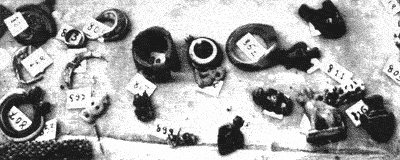
The Judaic Community on Yeb
Mysteriously, a Judaic community existed on Yeb sometime during the latter part of the ensuing dark period. It is clear that an already ancient, vibrant Judaic colony, among whose functions was to serve as a military outpost, had long been established on Yeb at the time of the Persian conquest of Egypt in the sixth century BCE16
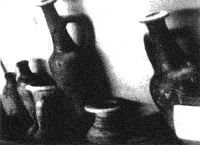
Archaeologists retrieved hundreds of sixth century BCE Aramaic documents from the Judaic quarter of the island. One of the documents records that a temple built by the garrison was already in existence when Cambyses invaded Egypt in 525 BCE. The existence of Judaic community for more than a century earlier is also implied in Deuteronomy, 17:16: "Only he (i.e., the king) is not to multiply horses; nor shall he send the people back to Egypt in order to multiply horses."
Donald Redford, in Egypt, Canaan and Israel in Ancient Times, points out that "Since it is beyond doubt that the "Book of the Law" found in the Jerusalem Temple in Josiah's eighteenth year (c. 623 B.C.) was an early version of Deuteronomy, the dispatch of Judaeans to Egypt must have been royal policy at the time in question... and perhaps already under Manasseh and Amon."17
Thus, it is evident that the Judaic presence on Yeb stretches far back into antiquity, albeit how far back it goes is unclear. The protocol of liturgic ritual detailed on some of the documents found on the island dates back to a time before the destruction of the First Temple in Jerusalem, making it manifest that the settlement was solidly established well before the sixth century BCE..
Life of the Judaic Yeb Community
Among the hundreds of recovered documents were commercial and real estate contracts, marriage agreements, and personal letters describe the daily secular and religious life of the community in considerable detail. One related group of these documents illustrate all these aspects of Judaic life on Yeb, and throw light on religious practices and the status of women in the community.
They concern the three marriages of the woman Mitbahiah. Her rights to property, inheritance, and divorce was in sharp contrast to those of women of other societies of the times. Of particular interest is that the extent of those rights were more progressive than those of some contemporary orthodox Judaic circles.
It appears from the records that Mitbahiah's father, suspicious of promiscuous behavior on the part of his daughter (evidently with good reason), concerned that she might divorce husbands too readily, carefully drafted a marriage contract intended to deter her from so doing while protecting her interests and those of her children:
"On the 21st of Chisleu... Masheiah B. Yedoniah, a Jew of Yeb... said to Jezaniah B. Uriah... there is the site of one house belonging to me... Which I have given to your Mitbahiah, my daughter, your wife... Now I say to you, build and equip that site and dwell on it with your wife. But you may not sell that house or give it as a present to others; only your children by my daughter Mitbahiah shall have power over it after you. If... you build upon this land and then my daughter divorces you and leaves you, she shall have no power over it, in return for the work you have done..."
Note that the document attests that a woman can readily divorce her husband, with or without his consent. In other documents this woman's right is executed by the woman "standing up in congregation and merely declaring "I divorce my husband." Thus we learn that, at least in sixth century BCE Yeb, women were not separated from the men in congregations, had property rights, and could take the initiative in and consummate a divorce simply by publicly declaring her intention. How liberal can you get!
Mitbahiah must have done very well in her investments, for other documents refer to a considerable fortune she lent to her father in the course of the next thirteen years. In partial payment of his debt to his daughter Masheiah deeded her a house he had acquired: "I give it to Mitbahiah, my daughter, in return for the goods which she gave me while I was an inspector of the fortress."
The extraordinarily progressive social mores of ancient Judaic society are confirmed by subsequent documents concerning Mitbahiah. She must have been some gal! Undeterred, she did divorce Jeremiah and married Pi', an Egyptian official in Aswan, and even temporarily adopted his religion. The Judaic community evidently disdained to recognize such a marriage, for none of the witnesses to the marriage contract had Hebrew (or Aramaic) names. The marriage lasted for what must have been little more than a honeymoon, certainly less than a year, for her next marriage took place in the same year. Pi' paid quite a price for marrying a Jewish "princess." All of Pi's property was divided between them, but the property that was in Mitbahiah's name remained with her!
Mitbahiah thereupon reverted to her own people and promptly went on to a prospective third husband, Asor b Seho. Ashor, like her father, was a Jew of some note; they were both listed as "builders to King Artexerxes." Mitbahiah's father, by now evidently was not averse to cashing in on his daughter's market value, and made certain that her property would not revert to Ashor in the event of a divorce. Ashor's guarantee states: "... I have given you as the bride-price of your daughter Mitbahiah Five shekels, royal weight. It has been received by you and your heart is content. Should Ashor die... having no child, male or female [!], by his wife Mitbahiah, Mitbahiah shall be entitled to the house, chattels and all other worldly goods of Ashor... Should Mitbahiah... stand up in a congregation and declare, I divorce my husband, the price of divorce shall be on her head; she shall... weigh out to Ashor 7 shekels, 2 R., but all she brought I with her she shall take out, shred and thread, and go wither she will without suit or process."
This time the marriage contract was signed by members of the Judaic community.
Historical Crimes of Omission and Commission
For four thousand years prior to the Common Era the Jews and their progenitors, the Canaanites and Akkadians, brought civilization to Egypt. Virtually every technological and cultural advance can be attributed to the presence of these peoples in Egypt, or to the passage and activities of Semitic traders from Southeast Asia.
The most remarkable transformation of Egypt from a primitive society to a Bronze Age culture took place during the two centuries of the so-called Second Intermediate Period under the rule of six Semitic chief-of-all-chiefs, elected by the chieftains of the numerous Aamu villages that proliferated in Lower Egypt from the time of Biblical Joseph forward.
With harder, more durable metal for their arms and tools, with wheeled chariots, and with draft animals for cultivation and transportation of new agricultural products, Egypt became the equal of the nations to the north and east. Yet, of all the events that took place in the time of the Asiatic chieftains, the most important was one that did not occur: there was no war of any consequence throughout the period of Aamu rule, the rule of the Semitic chieftains!
This fact has been misunderstood, or deliberately distorted, for it is said in our histories that during this time the power and influence of Egypt declined. These Aamu rulers did not build statues of mythical Gods, nor self-aggrandizing statues of themselves, nor fill massive tombs with the rich accouterments for the next life. Thus it is said that, during this period, art likewise declined.
How did it happen that modern historians consistently overlook the contribution of the Semitic Asiatics to Egyptian civilization?
It is painfully evident that plunder was too often the prime objective not only of collectors and greedy tomb-robbers but of museums. The accumulation of artifacts rather than facts was too often the driving motivation of scientific institutions. The destructive tomb-robbing of natives for personal gain became the prerogative of archaeologists, museums, private collectors, and even governments. It is not surprising, therefore, that insofar as few grandiose monuments or rich royal accouterments were gathered from the period of the tenure of the Semitic chiefs, that the modern plunderers were prone to blithely pronounce that nothing of value was contributed by them, and that, perforce, Egyptian civilization suffered a decline.
How sad it is that power is measured by what can be enforced by arms, and not by what can be furthered by influence; that richness is measured by the quantity of loot wrested from one's neighbors, not by the wealth created through increased productivity. How absurd it is to gauge the wealth of a country by how many golden artifacts can be plucked from its ruler's tombs rather than by the adequate diet of the dwellers in the land.; how blind is judgment when the welfare of a country like Egypt is assessed according to the profligacy of its Pharaohs rather than by the prosperity of its people.
Historical obtuseness cannot be attributed merely to an obsessive interest in accumulating the emoluments from noble tombs and edifices. Anti-Semitism fostered a willingness to adopt tendentious precepts uncritically. Anti-Semitism bolstered the credibility of those who were all too prone to ignore or deny gains by Egypt under Semitic rule.
What is unjustifiable is that historians continue to confuse conquest with progress, an historical distortion which is not confined to the history of Egypt. Clucking with satisfaction over artifacts scavenged from the grandiose tombs and palaces of ambitious conquerors, historians are inclined to assert that these worthies were instrumental in boosting their societies to new heights of cultural and economic development. They skip lightly over the tens or hundreds of thousands slaughtered in the process of conquest. It seems beside the point to mention the cities decimated, the countryside ravaged, the peoples enslaved. It seems of little importance that under the despotic rule that usually follows bloody conquest, people are grievously taxed, forced into slave or corvee labor, and that a great proportion of their labor is consumed not in promoting the general welfare but in touting the glory of the conquerors by the creation of those very works that fill museums.
Thirdly, much of history is taken from what the conquerors had inscribed on these works. Herodotus put it succinctly: "Such as think the tales told by the Egyptians credible are free to accept them for history. As for me, I keep to the plan of this book, which is to record the traditions of the various nations just as I heard them related to me."
Must we continue to judge a civilization by the size of its palaces and monuments? By the numbers of people subjugated? By how profligate are its rulers?
Or do we measure a civilization by its dedication to peaceful pursuits? By the economic well-being of its people? By its technological and cultural achievements? By the freedoms its citizens enjoy?
Of all the wonders wrought in Egypt under Aamu rule, none exceeds the Canal of Joseph for excellence, none testifies more eloquently to the their genius, none bears better witness to their accomplishments. Today, after more than three thousand years, the canal still functions vigorously and its feeder canals irrigate more territory than does the Aswan Dam. It performs its function benignly, unlike the dam, which increases the salinity of the soil and prevents the silting and natural fertilization of the farmland.
The canal has been and is still today designated the Bahr Youseff, which translates from the Egyptian to "The Sea of Joseph." It so appears on the maps of Biblical Mizraim, the land we call Egypt.
Notes
Space considerations have obliged us to defer numerous sources for facts included in the text above to two books by Samuel Kurinsky, from which the above dissertation was largely taken. Sources for un-notated facts can be found in: "Ancient Egyptian Historiography;""Semitic Culture and Technology Arrive in Egypt;" "The Transformation of Egypt under Canaanite Rule," Chapters, 4, 5 and 6 respectfully of The Eighth Day, The Hidden History of the Jewish Contribution to Civilization," Jason Aronson, New Jersey, 1994, pp. 59-128, and in: "Egyptian (sic) Glass," chapter 3 of The Glassmakers; an Odyssey of the Jews , Hippocrene Books, PP. 53-78.
Both books are available from the Hebrew History Federation Ltd.
- James Henry Breasted, A History of Egypt, 1905 (reprint, New York, Bantam Books 1964) p. 20.
- A. Rosalie David, The Ancient Egyptians, London, Routledge & Kegan Paul, 1982, p. 12.
- Percy S. P. Handcock, Mesopotamian Archaeology, New York, Kraus Reprint & Periodicals, 1963, p. 5
- Sir Alan Gardiner, Egypt of the Pharaohs, 1961, reprint Oxford Un. Press 1979, p.35.
- Will Durant, Our Oriental Heritage, 1935, reprint New York, Simon & Schuster, 1954, p. 135
- F. Wendorf et al, "Egyptian Prehistory; Some New Concepts," Science, 1969, pp. 1161-1171.
- Merimde beni-Salame was discovered by Professor Hermann Junker in the winter of 1927-28, director of the Vienna Academy of Science's expedition to Egypt
- Michael A. Hoffman, Egypt Before the Pharaohs, (London, Routledge & Kegan Paul, 1980, p. 169.
- Hoffman, Ibid., p. 186.
- H. J. Cantor, "The Relative Chronology of Egypt and its Foreign Correlations before the Bronze Age," in Chronologies on Old World Archaeology, ed. R. Ehrich, Chicago Un. Press, 1965, pp. 1-46.
- B.G. Trigger et al, "The Rise of Egyptian Civilization," in Ancient Egypt: A Social History 1983, reprint Cambridge Un. Press, 1986, pp. 25-6.
- Hoffman, Ibid., p. 214.
- Sir Alan Gardiner, Egypt of the Pharaohs, 1951, reprint, Oxford Un. Press, ,1979. Pp. 156-7.
- Manfred Bietak, "Urban Archaeology and the 'Town Problem' in Ancient Egypt", Egyptology (1979), 97, 119.
- A.S. Hemmy, Journal of Egyptian Archaeology, XXIII, 1937, p. 56. See also Charles Singer et al, A History o Technology, vol 1 (Weights and Measures) pp. 776-7, as for example: "The Egyptian short cubit of 6 palms and 24 digits (17.68 or 449 mm. Was also the early Jewish cubit at 17.60 (447 mm.).
- James B. Pritchard, ed., Ancient Near Eastern Texts Relating to the Old Testament., Princeton, 1969, p. 492.
- Donald B. Redford, Egypt, Canaan and Israel in Ancient Times, Princeton 1992, p. 444.
